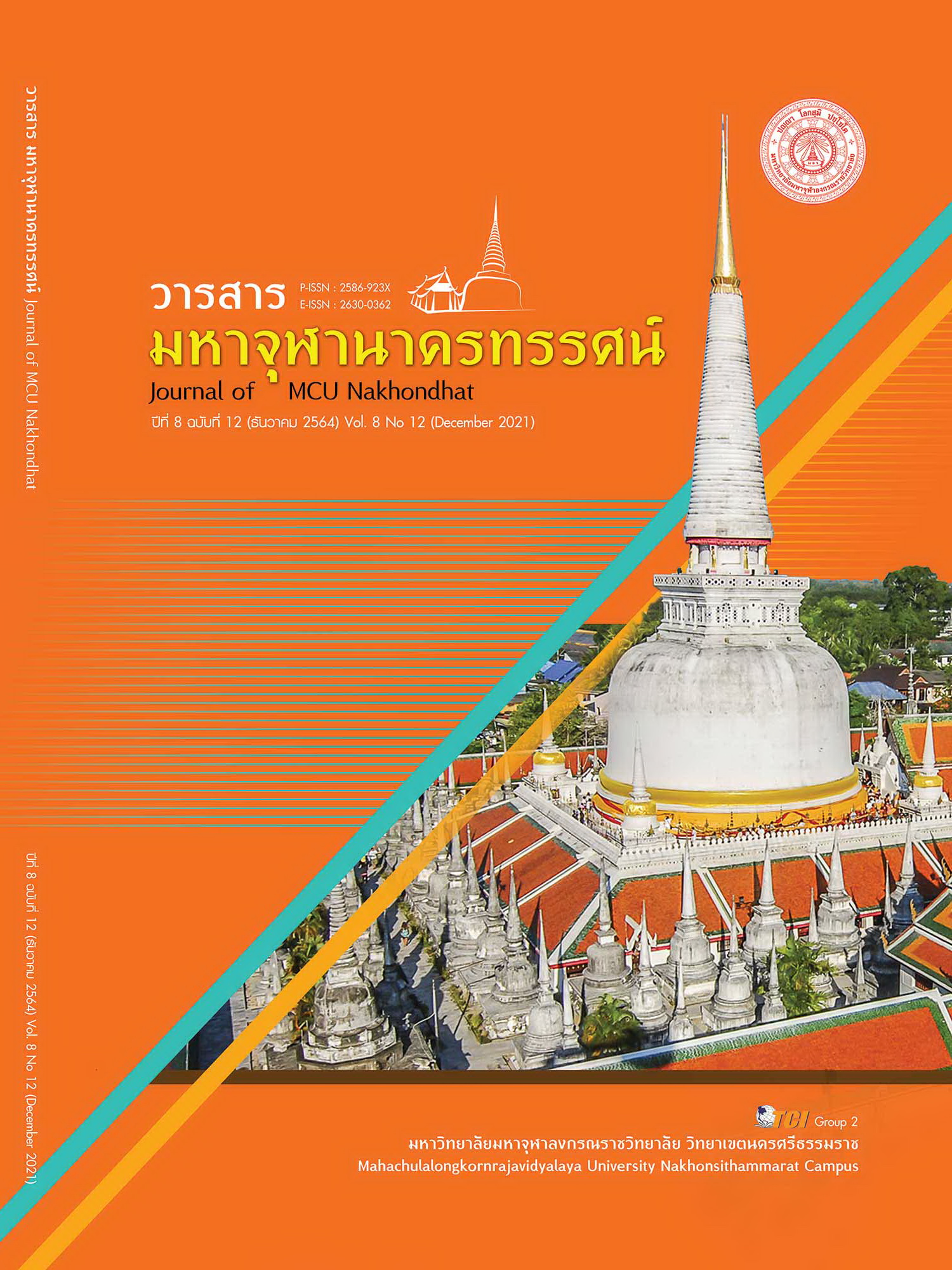FAMILY CENTER CARE IN PAIN WITH CHILD: APPLICATION IN CASE STUDY
Main Article Content
Abstract
Pain in children can be caused by both disease pathology and acute conditions, crisis and chronic conditions of disease. In some conditions, the illness requires pediatric patients to be treated by surgery or performing an operation or from the pathology of the disease itself This results in pain, fear, and anxiety for children and their families. Pain assessment and pain management with age differences are essential. In which childhood is unable to communicate to understand pain to meet their own needs. Therefore, it is imperative to have a family to take part in the care.The concept of family-centered child care will give priority to family. Encourage families to take part in caring and incorporating families into patient care plans. In addition, information was exchanged, child care decisions and taking care of family activities used in nursing practice. Family should be given priority in empowering and cooperating in child care. If without the support of the nurses this made the family unable to play their roles effectively. For the role of nurses in caring for children with pain using the family as the center. Recognizing and respecting the role of family is very important to children. Able to provide timely relief from pain relief and can be used as information in planning comprehensive maintenance and more efficient. Children feel warm, safe and reduce the impact on pediatric patients. It's a holistic care. This allows children with pain to be treated more effectively.
Article Details
References
จินดารัตน์ สมใจนึก และคณะ. (2559). ปัจจัยทำนายการปฏิบัติของการพยาบาลเด็กในการดูแลโดยมีครอบครัวเป็นศูนย์กลาง. วารสารพยาบาลศาสตร์, 34(2), 71-79.
ชูศักดิ์ ยืนนาน. (2560). แนวคิดการพยาบาลโดยเน้นครอบครัวเป็นศูนย์กลางในการดูแลผู้ป่วยเด็กในภาวะวิกฤติและเรื้อรัง. วารสารสมาคมพยาบาลแห่งประเทศไทยฯ สาขาภาคเหนือ, 23(2), 59-68.
ปาริชาติ ดำรงค์รักษ์ และคณะ. (2555). ผลของการดูแลโดยให้ครอบครัวเป็นศูนย์กลางต่อการรับรู้สมรรถนะของตนเองในการมีส่วนร่วมดูแลบุตรและความพึงพอใจในบริการพยาบาลของมารดาทารกเกิดก่อนกำหนดที่เข้ารับการรักษาในหออภิบาลทารกแรกเกิด. วารสารพยาบาลศาสตร์, 30(2), 71-79.
ปิยศักดิ์ วิทยบูรณานนท์ และหฤทัย โชติสุขรัตน์. (2559). ความปวดในเด็ก. วชิรเวชสารและวารสารเวชศาสตร์, 60(2), 135-145.
ยุพาภรณ์ ติรไพรวงศ์ และนุสรา ประเสริฐศรี. (2558). การมีส่วนร่วมของครอบครัวในการประเมินและจัดการความปวดของผู้ป่วยเด็กเล็ก. วารสารการพยาบาลและการศึกษา, 8(3), 1-13.
รุ่งนภา คำอ้อย และคณะ. (2559). การจัดการความปวดโดยบิดามารดาในผู้ป่วยเด็กหลังผ่าตัดและปัจจัยที่เกี่ยวข้อง. พยาบาลสาร, 43(2), 13-22.
โรส ภักดีโต. (2563). บทบาทพยาบาลในการจัดการความปวด : กรณีศึกษาผู้ป่วยเด็กวัยเรียนโรคมะเร็ง. พยาบาลตำรวจ, 12(2), 464-470.
วรรณฤดี เชาว์ศรีกุล. (2560). ประสบการณ์ : การดูแลผู้ป่วยเด็กเด็กพึ่งพาเครื่องช่วยหายใจที่บ้านโดยครอบครัวเป็นศูนย์กลาง. วารสารการพยาบาลการสาธารณสุขและการศึกษา, 18(2), 3-13.
ศิราคริน พิชัยสงคราม และคณะ. (2559). การดูแลโดยใช้ครอบครัวเป็นศูนย์กลางของนักศึกษาพยาบาลและผู้ดูแลเด็ก. วารสารการพยาบาลและการศึกษา, 9(1), 75-87.
สุภาพร คิดเห็น และคณะ. (2559). การรับรู้ความปวดและการจัดการความปวดในผู้ป่วยเด็กโรคธาลัสซีเมีย. วารสารพยาบาลศาสตร์และสุขภาพ, 39(1), 1-11.
อุษาษ์ โถหินัง. (2560). บทบาทพยาบาลในการดูแลเด็กปากแหว่งเพดานโหว่โดยให้ครอบครัวเป็นศูนย์กลาง : การบูรณาการแนวคิดของโอเร็มและแนวคิดการมีส่วนร่วมของดันสท์และทริเวทย์. วชิรสารการพยาบาล, 19(1), 10-18.
ฮัมดี มาแย และคณะ. (2563). ความสัมพันธ์ระหว่างความรู้และทัศนคติกับการจัดการความปวดของพยาบาลในหอผู้ป่วยเด็กวิกฤตภาคใต้. วารสารเครือข่ายวิทยาลัยพยาบาลและการสาธารณสุขภาคใต้, 7(3), 47-57.
Coker T. R. et al. (2010). Family centered care for US children with special health care needs : Who gets it and why. Pediatrics, 125(6), 1159-1167.
Davidson F., et al. (2016). Psychological Interventions in Managing Postoperative Pain in Children: A Systematic Review. Comprehensive Review, 157(9). 1872-1886.
Dodd, M. et al. (2001). Advancing the science of symptom management. Journal of Advanced Nursing, 33(5), 668-676.
Dunst C. J. & Trivette C. M. (1996). Empowerment, effective help giving practices and family-centered care. Pediatrics Nursing, 22(4), 334-337.
Hockenberry M. J. (2017). Wong’s Essentials of Pediatric Nursing. Louis: Missouri.
Johnston C. et al. (2014). Skin-to-skin care for procedural pain in neonates. Cochrane : Database Syst Rev.
Kahsay H. (2017). Assessment and treatment of pain in pediatric patients. Current Pediatric Research, 21(1), 148-157.
Lawrence J., et al. (1993). The development of a tool to assess neonatal pain. Neonatal Netw, 12(6), 59-66.
Manworren R. C. B & Stinson J. (2016). Pediatric pain measurement : assessment and evaluation. Seminars in Pediatric Neurology, 23(3), 189-200.
Merkel S. et al. (1997). The FLACC: a behavioral scale for scoring postoperative pain in young children. Pediatric Nursing, 23(3), 293-297.
Orem D.E. (2010). Nursing concept of practice. St Louis: Mosby.
Sadeghi H. et al. (2019). The impact of family centered care and meeting the need to learn how much of global anxiety in parents of children with urinary tract infection : a randomized clinical trial. International. Journal of Ayurvedic Medicin, 10(1), 68-74 .
Schellack N. & Matimela M. (2016). Pediatric pain management. South Africa Family Practice, 58(3), 42-47.
Suraseranivongse S. et al. (2005). Cross-validation of a self-report scale for postoperative pain in school-aged children. J Med Assoc Thai, 88(3), 412-418.
Syrjala K. L. & Abrams J. R. (2002). Hypnosis and imagery in the treatment of pain. New York: The Guilford.
Tarbell et al. (1992). The Toddler-Preschooler postoperative pain scale: an observational scale measuring postoperative pain in children aged 1–5. Preliminary report, 50(3). 273-280.
Wong D. (2016). Wong-Baker FACES Foundation. Retrieved August 15, 2021 from http://www.WongBakerFACES.org


